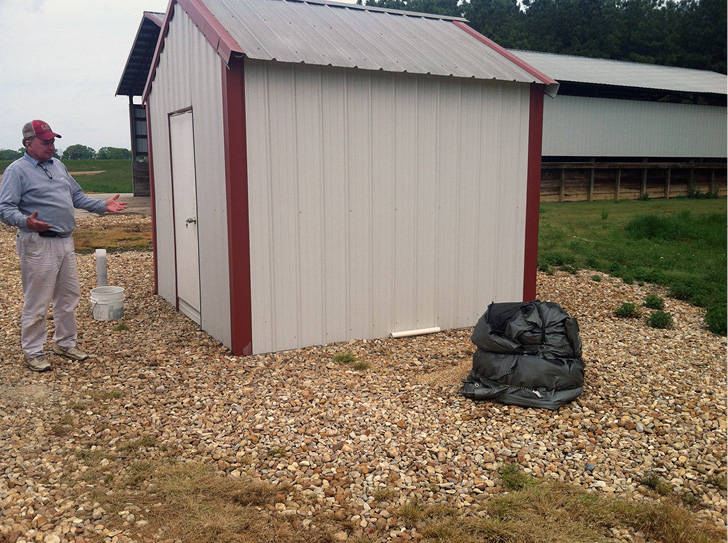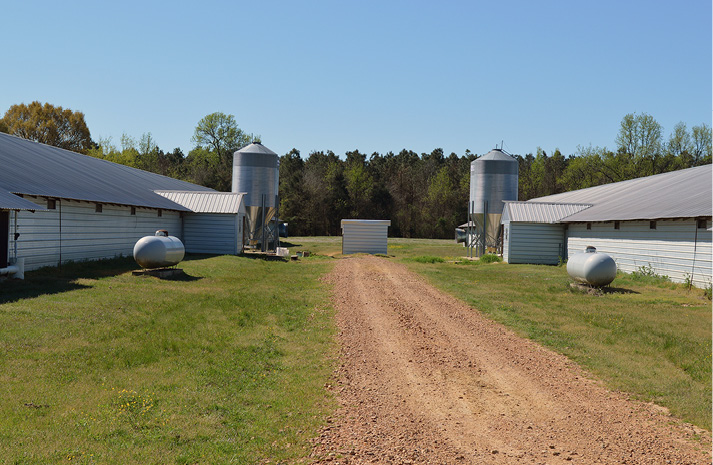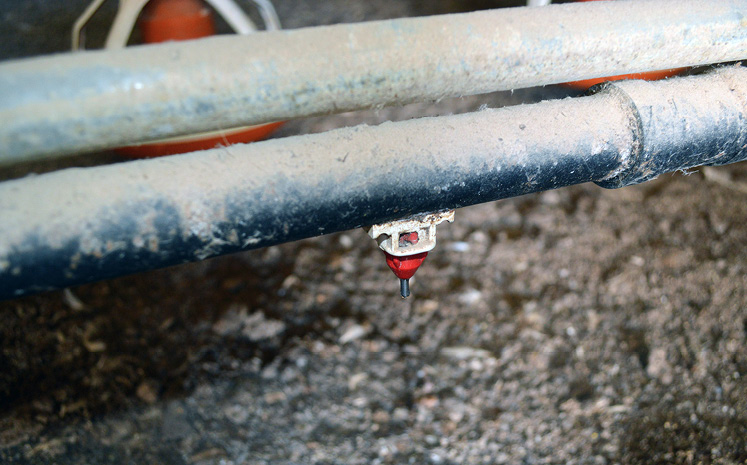Private Water Well Placement and Sizing for Poultry Production
Poultry production often takes place in rural areas that do not have access to a public water supply, and sometimes producers choose to have a well drilled to reduce the long-term cost of water. This publication gives guidance for well placement in proximity to poultry houses. Producers need to be aware of potential groundwater/surface water contamination, potential additional installation costs, and ease of use issues.
Groundwater and/or Surface Water Contamination
Private well placement is important because the well shaft is a direct conduit to the underground aquifer, which is the source of drinking water for your poultry and for any citizens with private wells tapped into the aquifer. A contaminated aquifer would be costly for a grower and detrimental to the health of people.
Groundwater contamination may occur as a result of components being released into the soil from such sources as a nearby septic system or septic system drain field. It is crucial that a producer have a minimum distance of 100 feet from a septic system, septic system drain field, or any potential source of pollution. If it is possible to know or determine the groundwater flow, the private well should be placed/drilled upstream or up-flow from any potential contaminant source.
Contamination by surface water may occur if the top of the well casing is compromised and/or open. The top of the well casing should be at least 1 foot above the ground. The ground around the well casing should slope down and away to ensure proper drainage. Always keep hazardous chemicals, such as paint, fertilizer, pesticides, and petroleum products, away from the well. Build the generator shed and diesel storage tank away from the well site to prevent the risk of a fuel spill from reaching the well shaft and contaminating the aquifer. Many producers build some form of house over the well casing to protect the casing and shaft from the environment and other dangers (such as cattle or other livestock) (Figure 1). Some producers pour a concrete slab around the well casing and build the house on the slab, while others simply build the house over the well without a slab. Some wells have no cover at all, and these, depending on where they are located, are most at risk of being compromised or contaminated.

Placement Recommendations
In most cases, the closer the well can be to the poultry houses, the better. Poultry houses are required (primarily by the integrator) to have two water sources—a rural water association and a private well, or two private wells. Many producers choose to drill the well(s) between the houses (Figure 2). This puts the supply conveniently near the demand. It also prevents having to lay long runs of pipe.

Water pressure is always a concern on poultry farms. Pushing water uphill from the well results in a pressure loss at the poultry house. (Feet x 0.433 = the amount of pressure loss from pushing water uphill.) For example, if the poultry houses are at an elevation 50 feet higher than the well, there will be a 21.7 psi (pounds per square inch) pressure loss between the well and the poultry houses (50 x 0.433 = 21.7) because of the elevation change. Even though you may have adequate pressure at the well, it may not be enough to push water to the end of the drinker lines or to the cool cells. This will be a major problem any time of the year, but it could be disastrous in the summer when big chickens are on the farm.
In addition, the resistance from water flowing through a pipe causes pressure loss. The Irrigation Association (www.irrigation.org) has developed friction loss charts that can help you determine the psi loss per 100 feet of pipe for various pipe sizes based on gallons per minute of flow rate. All pressure losses must be accounted for to determine if you have enough pressure at the chicken house to adequately meet peak water demand.
If possible, do not drill a well in a location that has recently had fill dirt added. It may be hard to avoid drilling through fill dirt because most poultry house construction requires that dirt pads be built to sufficiently support the poultry houses. Well drillers have a difficult time drilling through fill dirt. Even when they do drill through it, the filled-in area will be soft and unstable and will likely cave in, causing sand and sediment to follow the well shaft into the aquifer. This sand and sediment may then be picked up by the pump and pumped into the water supply to the poultry houses, clogging regulators and filters and causing other damage. There are sand filters and other options available to remove sediment and debris from poultry drinking water, but these are expensive and may not solve all the issues. When drilling through the fill dirt, well drillers may also experience a washout, causing water to come out of the ground perpendicular to the well shaft.
Producers often disagree with the well driller on exactly where the well should be located. However, in most cases, the well driller is right. Well drillers understand what works best when it comes to a location site and drilling a well. They understand the local area—both the aboveground topography and the aquifers that lie beneath. They have drilled wells for poultry farms before. In most cases, they will know how deep the well will need to be to find an adequate water supply and what kind of volume can be expected from a particular aquifer. If you and the driller disagree on a site for the well, listen to the reasons why the driller thinks a different site is better. Drillers are paid to drill wells, and, most likely, they will drill where you tell them. But keep in mind, they drill wells every day and have likely picked up a thing or two along the way about what works and doesn’t work and why.
Sizing Recommendations
Make sure that your supply line from the well to the chicken houses is large enough to carry the volume of water that your farm will need. An undersized main supply line is one of the most common problems found on poultry farms today. A typical 500-foot broiler house today requires about 2 gallons per minute (gpm) for drinking and 8 gpm for the cool cell pads for a total of 10 gpm per house; a larger house requires more water. That means a four-house farm would require the well to pump 40 gpm. It takes a 2-inch pipe to deliver 40 gpm. A six-house farm would require 60 gpm. It takes a 2½-inch pipe to deliver 60 gpm. Consider nothing less than a 2-inch supply line from the well to the chicken houses (Figure 3). Some producers have installed a 4-inch line. Consult with your integrator before drilling a well and know the requirements. Also, make sure that the pump in the bottom of the well is large enough to deliver the volume of water your farm will need. Having plenty of water in the well, regardless of where the well is located, will be of little value if you cannot get enough of it to your chickens.

Best Management Practices
When it comes to having a water well drilled, a chicken farmer is interested in the placement of the well for convenience and cost, whereas a well driller is interested in quantity and quality of water. The following Best Management Practices (BMPs) were developed based on the experiences of well drillers who have drilled many wells on poultry farms and of poultry farmers who have had wells drilled within the past 2 to 7 years.
- Have the water quality tested. Test for bacteria and treat the water with chlorine if needed. In addition, test the water’s pH. Water that is highly basic (≥8), when combined with mineral concentrations in the water, may reduce the life of cool cell pads. A test for both bacteria and minerals is the only way to know what is actually in the water you plan to provide to your chickens. Chickens seem to prefer a pH in the range of 6.2 to 6.8. Water treatments are available to correct a pH that is extremely high or extremely low.
- Hire a licensed, reputable well driller, and make sure the desired gallons per minute can be produced before the well is drilled and the pump is set.
- With water line placement, think about potential future upgrades (for example, adding additional houses or retrofitting current houses), access in case of a leak, and proximity to large vehicle traffic (18-wheelers or tractors). Properly sized and installed pumps, piping, and other equipment to get water to the houses will save time, labor, and money now and in the future.
- If a bathroom is installed close to the control room or well house, make sure the septic tank and the septic tank field line are at least 100 feet from the well.
- Well placement should allow for loadout of the houses. You need at least 100 feet between the front of the houses and the well (if the well must be placed at the front of the house).
Common Questions and What You Need to Know
Ask yourself these questions to help determine your water needs:
- How much water does a poultry house use?
- How much water will all my poultry houses use?
- What size should my main supply line from the well be?
- How can I tell if I am short on water?
- Do I need water storage tanks?
- What are my options?
Then, determine the following factors to help you estimate your water needs:
- Tunnel fan capacity
- Type of pad system (cool cell, fogger; 2”, 4”, 6”)
- Number of birds and bird size you will grow
- Drinking water needs
- Number of houses
- Main supply line and meter size (3/4”, 1”, 2”)
- Farm layout and location (Is water being pushed uphill?)
These are the most common problems associated with water delivery:
- Poor planning
- Undersized main supply line
- Undersized meters
- Distance between farm and main line
- Change in elevation
- No municipal supply available
- Insufficient well capacity
- Failure to maintain drinker system
- Not checking water availability before building
- Too many houses for the amount of water available
- Adding additional houses that overloads availability
- Retrofitting beyond water supply capability
- Failure to regularly test water supply
- No backup plan in place should something happen
The information given here is for educational purposes only. References to commercial products, trade names, or suppliers are made with the understanding that no endorsement is implied and that no discrimination against other products or suppliers is intended.
Publication 2953 (POD-05-22)
By Jason R. Barrett, PhD, Associate Extension Professor, Water Resources Research Institute, and Tom Tabler, PhD, former Extension Professor, Poultry Science.
The Mississippi State University Extension Service is working to ensure all web content is accessible to all users. If you need assistance accessing any of our content, please email the webteam or call 662-325-2262.






